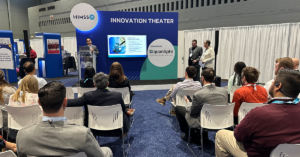By this point, we’ve all heard the statistic that healthcare data is growing at 36% annually. The result of this growth is that we’re all swimming in charts that, unfortunately, often lack a narrative to help a data consumer easily grasp the key takeaways. Your organization likely has a set of standard reports and dashboards that are distributed to stakeholders regularly. Increasingly, those dashboards just add to the white noise of data that surrounds you instead of providing insights and leading to action in the way they were intended.
But organizations are cutting through that noise by adding narrative insights to their data–that is, machine-assisted findings written in plain text that help busy decision-makers see, understand and act on key insights quickly.
Tell your data story
A data dashboard is a medium for telling a story with data, but the consumers of the data must be able to adequately and accurately interpret it to inform the correct actions. Organizations found that as they move business intelligence from the IT department that even with low code, self-service dashboard tools, they have a shortage of employees who know how to choose the right data for analysis. Many don’t know how to create the appropriate data visualization to ensure they are contextualizing the information to tell the right story.
While visualization can help someone see a trend faster, the nuance of the trend requires a larger perspective. To make an impact with analytics, dashboards need to tell a story that can be told across the organization from executives to managers to front-line employees.
Augment your analytics reality
Augmented analytics, which uses machine learning and artificial intelligence (AI) in conjunction with traditional analysts and analytics, can help close data literacy gaps through a combination of algorithms to find key data insights and natural language generation to present results to data consumers who may not be data scientists. AI algorithms may find data patterns and contributors that a human would not have thought to look for, and thus couldn’t find, and natural language generation can help call out or identify key findings from a data visualization that may have been difficult for the human eye to find, such as totals across the categories of a bar chart.
As organizations continue to rely more heavily on data-driven decisions, augmented analytics allows for faster and broader adoption of data. Employees who are not trained data scientists can quickly and easily see the key points of a data story, written in plain language and available for self-service.
These data stories can be displayed on a desktop, tablet or smartphone because the combination of charts and narratives pull the reader through the data and bubble up critical insights on the metrics that matter the most to them.
Augmented analytics can help serve up those insights and turn them into topics a user can follow. This way, if major changes occur, a user can be alerted and provided context on the drivers of the shift. This drives more value from analytics across all levels and skillsets within an organization.
Altogether, augmenting your organization’s data reality is an important step you can take to help more people better understand existing data. So, augment your reality today and improve tomorrow’s operational, financial and clinical outcomes.
Get our take on industry trends
Best practice tools to build an integrated approach to multimorbidity
The traditional model of treating single diseases no longer works. Data collected from 2016 to 2019 indicated that 32.9% of…
Read on...Will adopting a risk-based approach with augmented analytics support care gap closure?
A common challenge for healthcare systems is how to properly segment its patient populations based on risk profiles and co-morbidities. Doing this well ensures a high quality of care delivery and superior patient outcomes.
Read on...4 questions healthcare executives are asking about augmented analytics
At our annual Impact Summit, I had the privilege to talk about augmented analytics and address questions from healthcare executives—many…
Read on...


